Inclusive Lesson Planning: Strategies for Effective Teaching
VerifiedAdded on 2023/06/14
|19
|5364
|424
Report
AI Summary
This assignment solution provides a detailed overview of lesson planning, emphasizing inclusivity and responsiveness to diverse learner needs and abilities. It explores the main aims of lesson planning, features of effective lesson plans, and strategies for designing plans that meet learner goals. The report evaluates learning styles and taxonomies, detailing how they can be incorporated into lesson plans to ensure inclusivity. It also discusses the importance of adaptability and flexibility in lesson plan design and how this affects the delivery of inclusive teaching and learning. The assignment includes a sample lesson plan and an analysis of appraisal and evaluation methods, highlighting their role in communicating teaching preparation and addressing individual learner needs. This document is available on Desklib, a platform offering a variety of study tools and resources for students.
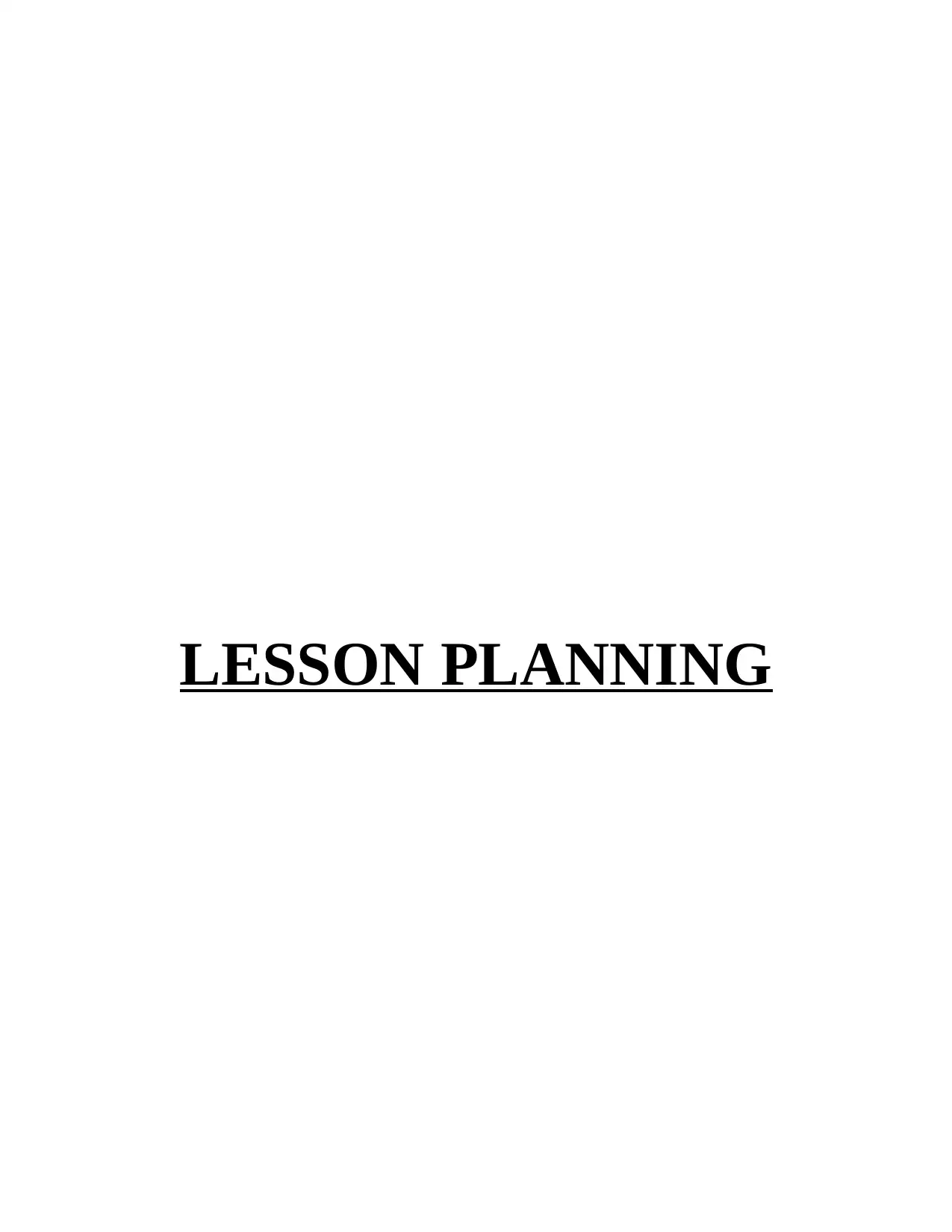
LESSON PLANNING
Paraphrase This Document
Need a fresh take? Get an instant paraphrase of this document with our AI Paraphraser
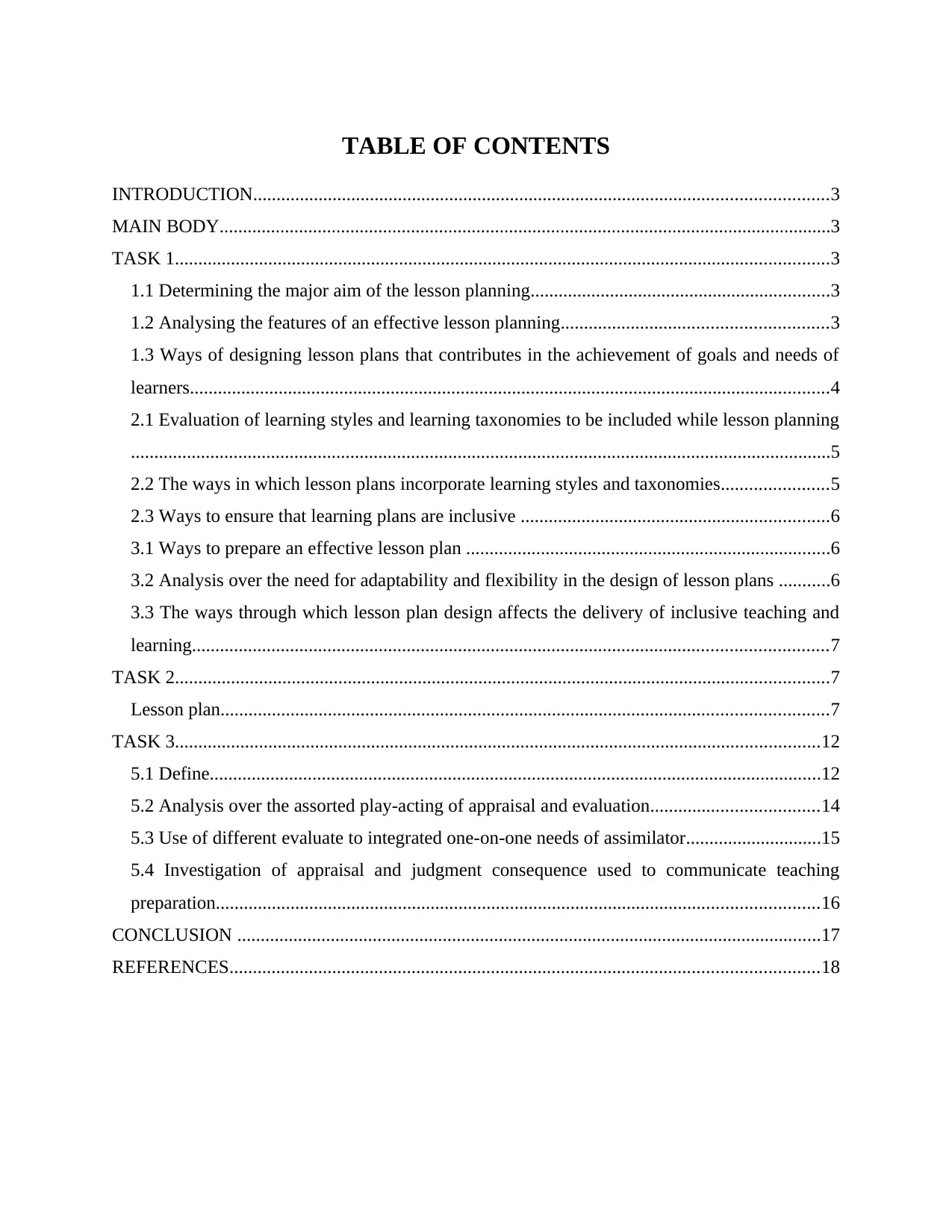
TABLE OF CONTENTS
INTRODUCTION...........................................................................................................................3
MAIN BODY...................................................................................................................................3
TASK 1............................................................................................................................................3
1.1 Determining the major aim of the lesson planning................................................................3
1.2 Analysing the features of an effective lesson planning.........................................................3
1.3 Ways of designing lesson plans that contributes in the achievement of goals and needs of
learners.........................................................................................................................................4
2.1 Evaluation of learning styles and learning taxonomies to be included while lesson planning
......................................................................................................................................................5
2.2 The ways in which lesson plans incorporate learning styles and taxonomies.......................5
2.3 Ways to ensure that learning plans are inclusive ..................................................................6
3.1 Ways to prepare an effective lesson plan ..............................................................................6
3.2 Analysis over the need for adaptability and flexibility in the design of lesson plans ...........6
3.3 The ways through which lesson plan design affects the delivery of inclusive teaching and
learning........................................................................................................................................7
TASK 2............................................................................................................................................7
Lesson plan..................................................................................................................................7
TASK 3..........................................................................................................................................12
5.1 Define...................................................................................................................................12
5.2 Analysis over the assorted play-acting of appraisal and evaluation....................................14
5.3 Use of different evaluate to integrated one-on-one needs of assimilator.............................15
5.4 Investigation of appraisal and judgment consequence used to communicate teaching
preparation.................................................................................................................................16
CONCLUSION .............................................................................................................................17
REFERENCES..............................................................................................................................18
INTRODUCTION...........................................................................................................................3
MAIN BODY...................................................................................................................................3
TASK 1............................................................................................................................................3
1.1 Determining the major aim of the lesson planning................................................................3
1.2 Analysing the features of an effective lesson planning.........................................................3
1.3 Ways of designing lesson plans that contributes in the achievement of goals and needs of
learners.........................................................................................................................................4
2.1 Evaluation of learning styles and learning taxonomies to be included while lesson planning
......................................................................................................................................................5
2.2 The ways in which lesson plans incorporate learning styles and taxonomies.......................5
2.3 Ways to ensure that learning plans are inclusive ..................................................................6
3.1 Ways to prepare an effective lesson plan ..............................................................................6
3.2 Analysis over the need for adaptability and flexibility in the design of lesson plans ...........6
3.3 The ways through which lesson plan design affects the delivery of inclusive teaching and
learning........................................................................................................................................7
TASK 2............................................................................................................................................7
Lesson plan..................................................................................................................................7
TASK 3..........................................................................................................................................12
5.1 Define...................................................................................................................................12
5.2 Analysis over the assorted play-acting of appraisal and evaluation....................................14
5.3 Use of different evaluate to integrated one-on-one needs of assimilator.............................15
5.4 Investigation of appraisal and judgment consequence used to communicate teaching
preparation.................................................................................................................................16
CONCLUSION .............................................................................................................................17
REFERENCES..............................................................................................................................18
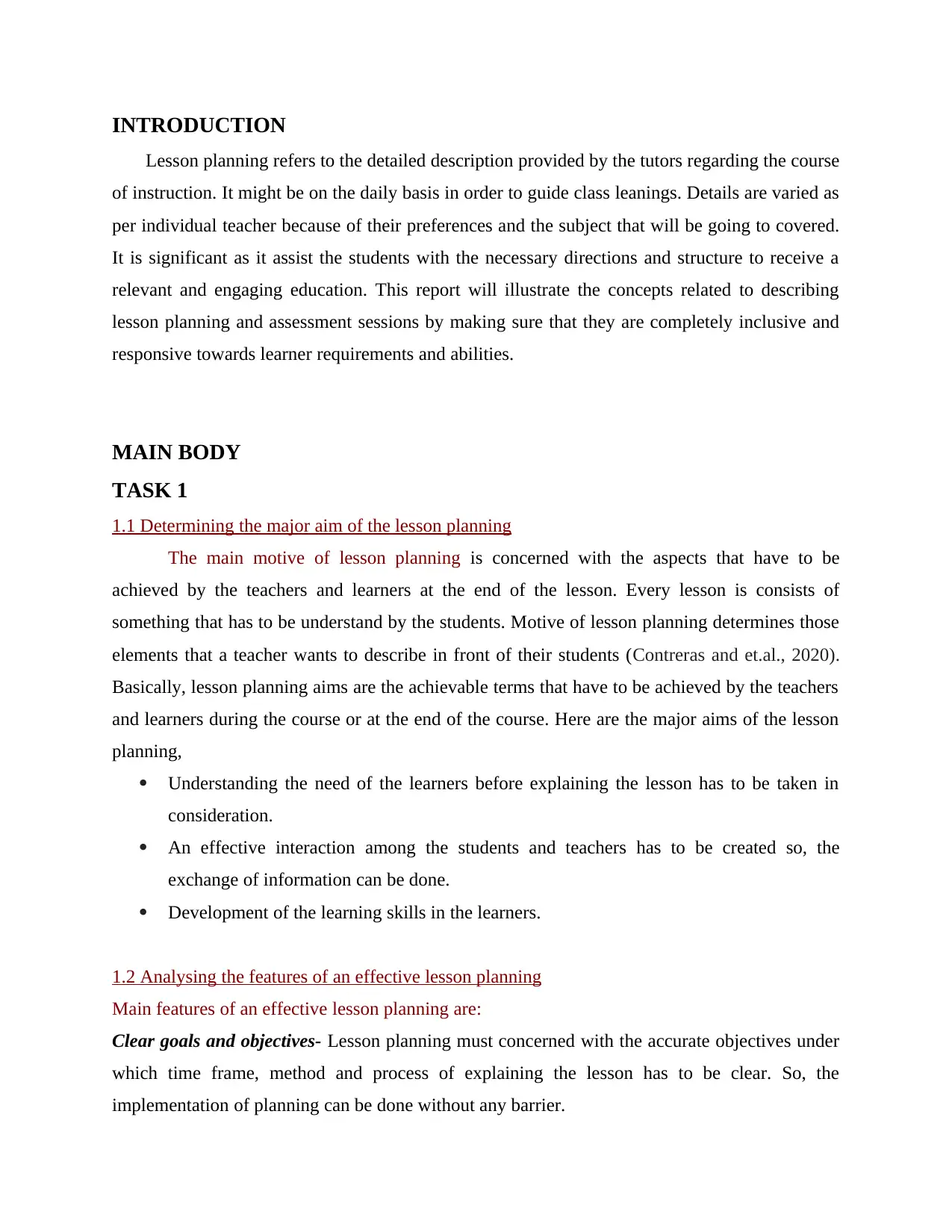
INTRODUCTION
Lesson planning refers to the detailed description provided by the tutors regarding the course
of instruction. It might be on the daily basis in order to guide class leanings. Details are varied as
per individual teacher because of their preferences and the subject that will be going to covered.
It is significant as it assist the students with the necessary directions and structure to receive a
relevant and engaging education. This report will illustrate the concepts related to describing
lesson planning and assessment sessions by making sure that they are completely inclusive and
responsive towards learner requirements and abilities.
MAIN BODY
TASK 1
1.1 Determining the major aim of the lesson planning
The main motive of lesson planning is concerned with the aspects that have to be
achieved by the teachers and learners at the end of the lesson. Every lesson is consists of
something that has to be understand by the students. Motive of lesson planning determines those
elements that a teacher wants to describe in front of their students (Contreras and et.al., 2020).
Basically, lesson planning aims are the achievable terms that have to be achieved by the teachers
and learners during the course or at the end of the course. Here are the major aims of the lesson
planning,
Understanding the need of the learners before explaining the lesson has to be taken in
consideration.
An effective interaction among the students and teachers has to be created so, the
exchange of information can be done.
Development of the learning skills in the learners.
1.2 Analysing the features of an effective lesson planning
Main features of an effective lesson planning are:
Clear goals and objectives- Lesson planning must concerned with the accurate objectives under
which time frame, method and process of explaining the lesson has to be clear. So, the
implementation of planning can be done without any barrier.
Lesson planning refers to the detailed description provided by the tutors regarding the course
of instruction. It might be on the daily basis in order to guide class leanings. Details are varied as
per individual teacher because of their preferences and the subject that will be going to covered.
It is significant as it assist the students with the necessary directions and structure to receive a
relevant and engaging education. This report will illustrate the concepts related to describing
lesson planning and assessment sessions by making sure that they are completely inclusive and
responsive towards learner requirements and abilities.
MAIN BODY
TASK 1
1.1 Determining the major aim of the lesson planning
The main motive of lesson planning is concerned with the aspects that have to be
achieved by the teachers and learners at the end of the lesson. Every lesson is consists of
something that has to be understand by the students. Motive of lesson planning determines those
elements that a teacher wants to describe in front of their students (Contreras and et.al., 2020).
Basically, lesson planning aims are the achievable terms that have to be achieved by the teachers
and learners during the course or at the end of the course. Here are the major aims of the lesson
planning,
Understanding the need of the learners before explaining the lesson has to be taken in
consideration.
An effective interaction among the students and teachers has to be created so, the
exchange of information can be done.
Development of the learning skills in the learners.
1.2 Analysing the features of an effective lesson planning
Main features of an effective lesson planning are:
Clear goals and objectives- Lesson planning must concerned with the accurate objectives under
which time frame, method and process of explaining the lesson has to be clear. So, the
implementation of planning can be done without any barrier.
⊘ This is a preview!⊘
Do you want full access?
Subscribe today to unlock all pages.

Trusted by 1+ million students worldwide
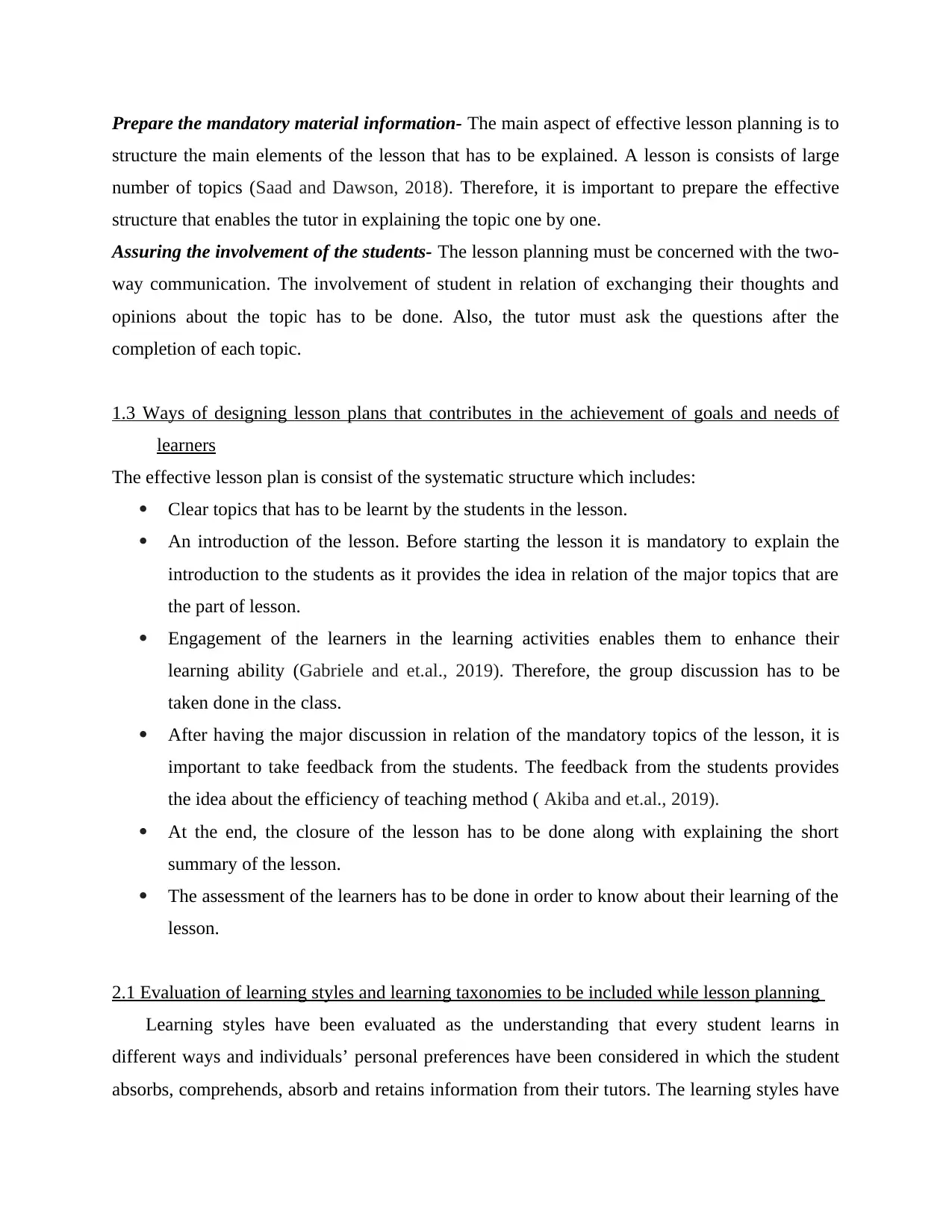
Prepare the mandatory material information- The main aspect of effective lesson planning is to
structure the main elements of the lesson that has to be explained. A lesson is consists of large
number of topics (Saad and Dawson, 2018). Therefore, it is important to prepare the effective
structure that enables the tutor in explaining the topic one by one.
Assuring the involvement of the students- The lesson planning must be concerned with the two-
way communication. The involvement of student in relation of exchanging their thoughts and
opinions about the topic has to be done. Also, the tutor must ask the questions after the
completion of each topic.
1.3 Ways of designing lesson plans that contributes in the achievement of goals and needs of
learners
The effective lesson plan is consist of the systematic structure which includes:
Clear topics that has to be learnt by the students in the lesson.
An introduction of the lesson. Before starting the lesson it is mandatory to explain the
introduction to the students as it provides the idea in relation of the major topics that are
the part of lesson.
Engagement of the learners in the learning activities enables them to enhance their
learning ability (Gabriele and et.al., 2019). Therefore, the group discussion has to be
taken done in the class.
After having the major discussion in relation of the mandatory topics of the lesson, it is
important to take feedback from the students. The feedback from the students provides
the idea about the efficiency of teaching method ( Akiba and et.al., 2019).
At the end, the closure of the lesson has to be done along with explaining the short
summary of the lesson.
The assessment of the learners has to be done in order to know about their learning of the
lesson.
2.1 Evaluation of learning styles and learning taxonomies to be included while lesson planning
Learning styles have been evaluated as the understanding that every student learns in
different ways and individuals’ personal preferences have been considered in which the student
absorbs, comprehends, absorb and retains information from their tutors. The learning styles have
structure the main elements of the lesson that has to be explained. A lesson is consists of large
number of topics (Saad and Dawson, 2018). Therefore, it is important to prepare the effective
structure that enables the tutor in explaining the topic one by one.
Assuring the involvement of the students- The lesson planning must be concerned with the two-
way communication. The involvement of student in relation of exchanging their thoughts and
opinions about the topic has to be done. Also, the tutor must ask the questions after the
completion of each topic.
1.3 Ways of designing lesson plans that contributes in the achievement of goals and needs of
learners
The effective lesson plan is consist of the systematic structure which includes:
Clear topics that has to be learnt by the students in the lesson.
An introduction of the lesson. Before starting the lesson it is mandatory to explain the
introduction to the students as it provides the idea in relation of the major topics that are
the part of lesson.
Engagement of the learners in the learning activities enables them to enhance their
learning ability (Gabriele and et.al., 2019). Therefore, the group discussion has to be
taken done in the class.
After having the major discussion in relation of the mandatory topics of the lesson, it is
important to take feedback from the students. The feedback from the students provides
the idea about the efficiency of teaching method ( Akiba and et.al., 2019).
At the end, the closure of the lesson has to be done along with explaining the short
summary of the lesson.
The assessment of the learners has to be done in order to know about their learning of the
lesson.
2.1 Evaluation of learning styles and learning taxonomies to be included while lesson planning
Learning styles have been evaluated as the understanding that every student learns in
different ways and individuals’ personal preferences have been considered in which the student
absorbs, comprehends, absorb and retains information from their tutors. The learning styles have
Paraphrase This Document
Need a fresh take? Get an instant paraphrase of this document with our AI Paraphraser
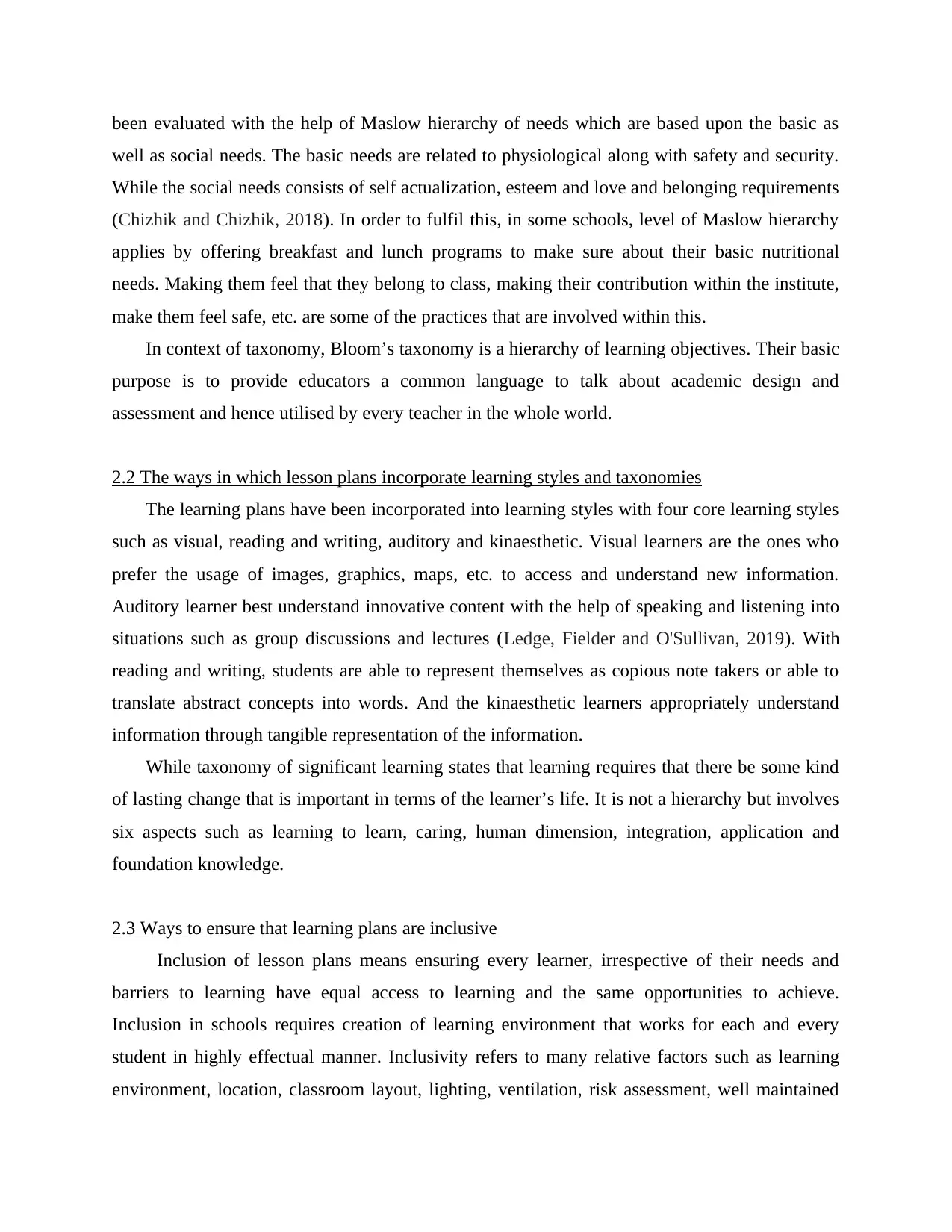
been evaluated with the help of Maslow hierarchy of needs which are based upon the basic as
well as social needs. The basic needs are related to physiological along with safety and security.
While the social needs consists of self actualization, esteem and love and belonging requirements
(Chizhik and Chizhik, 2018). In order to fulfil this, in some schools, level of Maslow hierarchy
applies by offering breakfast and lunch programs to make sure about their basic nutritional
needs. Making them feel that they belong to class, making their contribution within the institute,
make them feel safe, etc. are some of the practices that are involved within this.
In context of taxonomy, Bloom’s taxonomy is a hierarchy of learning objectives. Their basic
purpose is to provide educators a common language to talk about academic design and
assessment and hence utilised by every teacher in the whole world.
2.2 The ways in which lesson plans incorporate learning styles and taxonomies
The learning plans have been incorporated into learning styles with four core learning styles
such as visual, reading and writing, auditory and kinaesthetic. Visual learners are the ones who
prefer the usage of images, graphics, maps, etc. to access and understand new information.
Auditory learner best understand innovative content with the help of speaking and listening into
situations such as group discussions and lectures (Ledge, Fielder and O'Sullivan, 2019). With
reading and writing, students are able to represent themselves as copious note takers or able to
translate abstract concepts into words. And the kinaesthetic learners appropriately understand
information through tangible representation of the information.
While taxonomy of significant learning states that learning requires that there be some kind
of lasting change that is important in terms of the learner’s life. It is not a hierarchy but involves
six aspects such as learning to learn, caring, human dimension, integration, application and
foundation knowledge.
2.3 Ways to ensure that learning plans are inclusive
Inclusion of lesson plans means ensuring every learner, irrespective of their needs and
barriers to learning have equal access to learning and the same opportunities to achieve.
Inclusion in schools requires creation of learning environment that works for each and every
student in highly effectual manner. Inclusivity refers to many relative factors such as learning
environment, location, classroom layout, lighting, ventilation, risk assessment, well maintained
well as social needs. The basic needs are related to physiological along with safety and security.
While the social needs consists of self actualization, esteem and love and belonging requirements
(Chizhik and Chizhik, 2018). In order to fulfil this, in some schools, level of Maslow hierarchy
applies by offering breakfast and lunch programs to make sure about their basic nutritional
needs. Making them feel that they belong to class, making their contribution within the institute,
make them feel safe, etc. are some of the practices that are involved within this.
In context of taxonomy, Bloom’s taxonomy is a hierarchy of learning objectives. Their basic
purpose is to provide educators a common language to talk about academic design and
assessment and hence utilised by every teacher in the whole world.
2.2 The ways in which lesson plans incorporate learning styles and taxonomies
The learning plans have been incorporated into learning styles with four core learning styles
such as visual, reading and writing, auditory and kinaesthetic. Visual learners are the ones who
prefer the usage of images, graphics, maps, etc. to access and understand new information.
Auditory learner best understand innovative content with the help of speaking and listening into
situations such as group discussions and lectures (Ledge, Fielder and O'Sullivan, 2019). With
reading and writing, students are able to represent themselves as copious note takers or able to
translate abstract concepts into words. And the kinaesthetic learners appropriately understand
information through tangible representation of the information.
While taxonomy of significant learning states that learning requires that there be some kind
of lasting change that is important in terms of the learner’s life. It is not a hierarchy but involves
six aspects such as learning to learn, caring, human dimension, integration, application and
foundation knowledge.
2.3 Ways to ensure that learning plans are inclusive
Inclusion of lesson plans means ensuring every learner, irrespective of their needs and
barriers to learning have equal access to learning and the same opportunities to achieve.
Inclusion in schools requires creation of learning environment that works for each and every
student in highly effectual manner. Inclusivity refers to many relative factors such as learning
environment, location, classroom layout, lighting, ventilation, risk assessment, well maintained
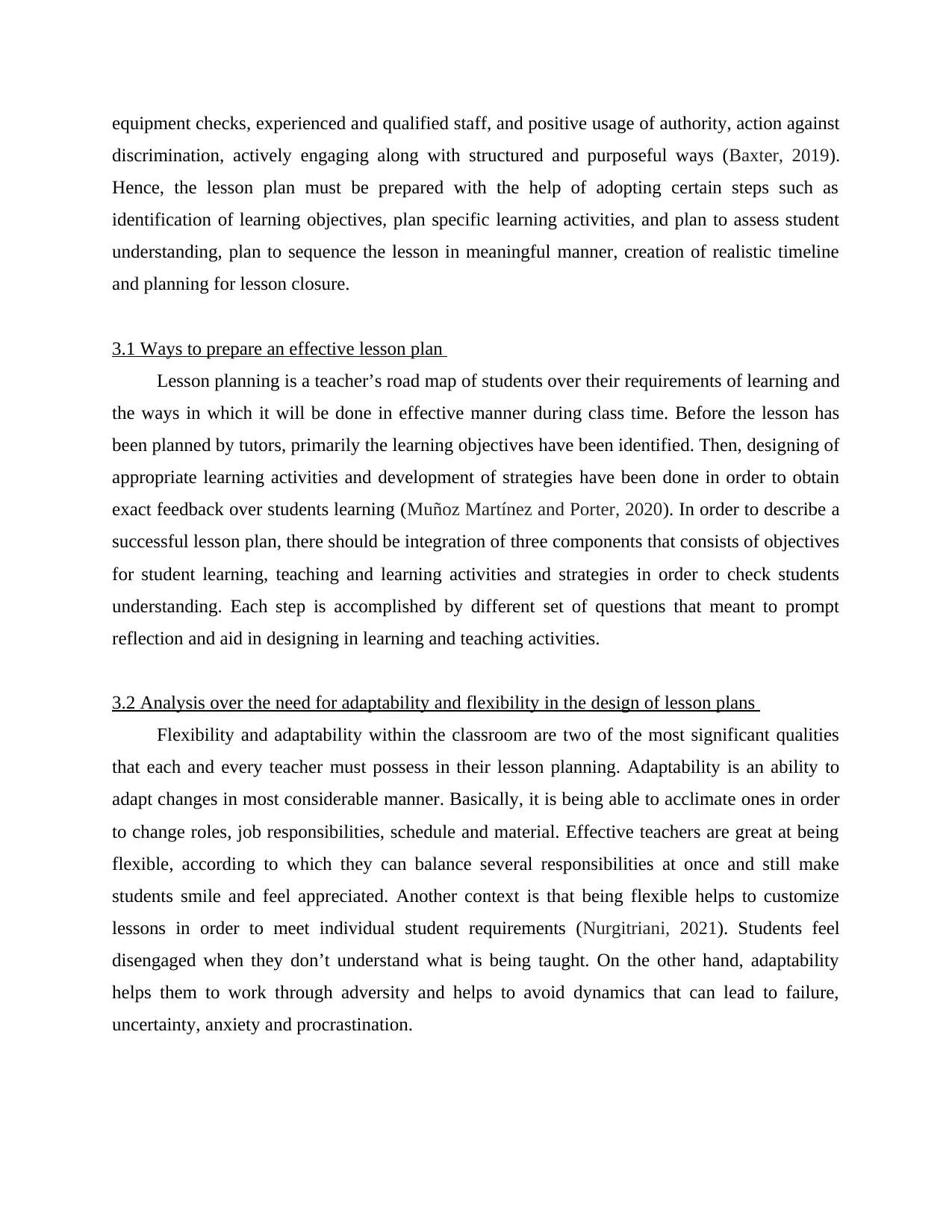
equipment checks, experienced and qualified staff, and positive usage of authority, action against
discrimination, actively engaging along with structured and purposeful ways (Baxter, 2019).
Hence, the lesson plan must be prepared with the help of adopting certain steps such as
identification of learning objectives, plan specific learning activities, and plan to assess student
understanding, plan to sequence the lesson in meaningful manner, creation of realistic timeline
and planning for lesson closure.
3.1 Ways to prepare an effective lesson plan
Lesson planning is a teacher’s road map of students over their requirements of learning and
the ways in which it will be done in effective manner during class time. Before the lesson has
been planned by tutors, primarily the learning objectives have been identified. Then, designing of
appropriate learning activities and development of strategies have been done in order to obtain
exact feedback over students learning (Muñoz Martínez and Porter, 2020). In order to describe a
successful lesson plan, there should be integration of three components that consists of objectives
for student learning, teaching and learning activities and strategies in order to check students
understanding. Each step is accomplished by different set of questions that meant to prompt
reflection and aid in designing in learning and teaching activities.
3.2 Analysis over the need for adaptability and flexibility in the design of lesson plans
Flexibility and adaptability within the classroom are two of the most significant qualities
that each and every teacher must possess in their lesson planning. Adaptability is an ability to
adapt changes in most considerable manner. Basically, it is being able to acclimate ones in order
to change roles, job responsibilities, schedule and material. Effective teachers are great at being
flexible, according to which they can balance several responsibilities at once and still make
students smile and feel appreciated. Another context is that being flexible helps to customize
lessons in order to meet individual student requirements (Nurgitriani, 2021). Students feel
disengaged when they don’t understand what is being taught. On the other hand, adaptability
helps them to work through adversity and helps to avoid dynamics that can lead to failure,
uncertainty, anxiety and procrastination.
discrimination, actively engaging along with structured and purposeful ways (Baxter, 2019).
Hence, the lesson plan must be prepared with the help of adopting certain steps such as
identification of learning objectives, plan specific learning activities, and plan to assess student
understanding, plan to sequence the lesson in meaningful manner, creation of realistic timeline
and planning for lesson closure.
3.1 Ways to prepare an effective lesson plan
Lesson planning is a teacher’s road map of students over their requirements of learning and
the ways in which it will be done in effective manner during class time. Before the lesson has
been planned by tutors, primarily the learning objectives have been identified. Then, designing of
appropriate learning activities and development of strategies have been done in order to obtain
exact feedback over students learning (Muñoz Martínez and Porter, 2020). In order to describe a
successful lesson plan, there should be integration of three components that consists of objectives
for student learning, teaching and learning activities and strategies in order to check students
understanding. Each step is accomplished by different set of questions that meant to prompt
reflection and aid in designing in learning and teaching activities.
3.2 Analysis over the need for adaptability and flexibility in the design of lesson plans
Flexibility and adaptability within the classroom are two of the most significant qualities
that each and every teacher must possess in their lesson planning. Adaptability is an ability to
adapt changes in most considerable manner. Basically, it is being able to acclimate ones in order
to change roles, job responsibilities, schedule and material. Effective teachers are great at being
flexible, according to which they can balance several responsibilities at once and still make
students smile and feel appreciated. Another context is that being flexible helps to customize
lessons in order to meet individual student requirements (Nurgitriani, 2021). Students feel
disengaged when they don’t understand what is being taught. On the other hand, adaptability
helps them to work through adversity and helps to avoid dynamics that can lead to failure,
uncertainty, anxiety and procrastination.
⊘ This is a preview!⊘
Do you want full access?
Subscribe today to unlock all pages.

Trusted by 1+ million students worldwide
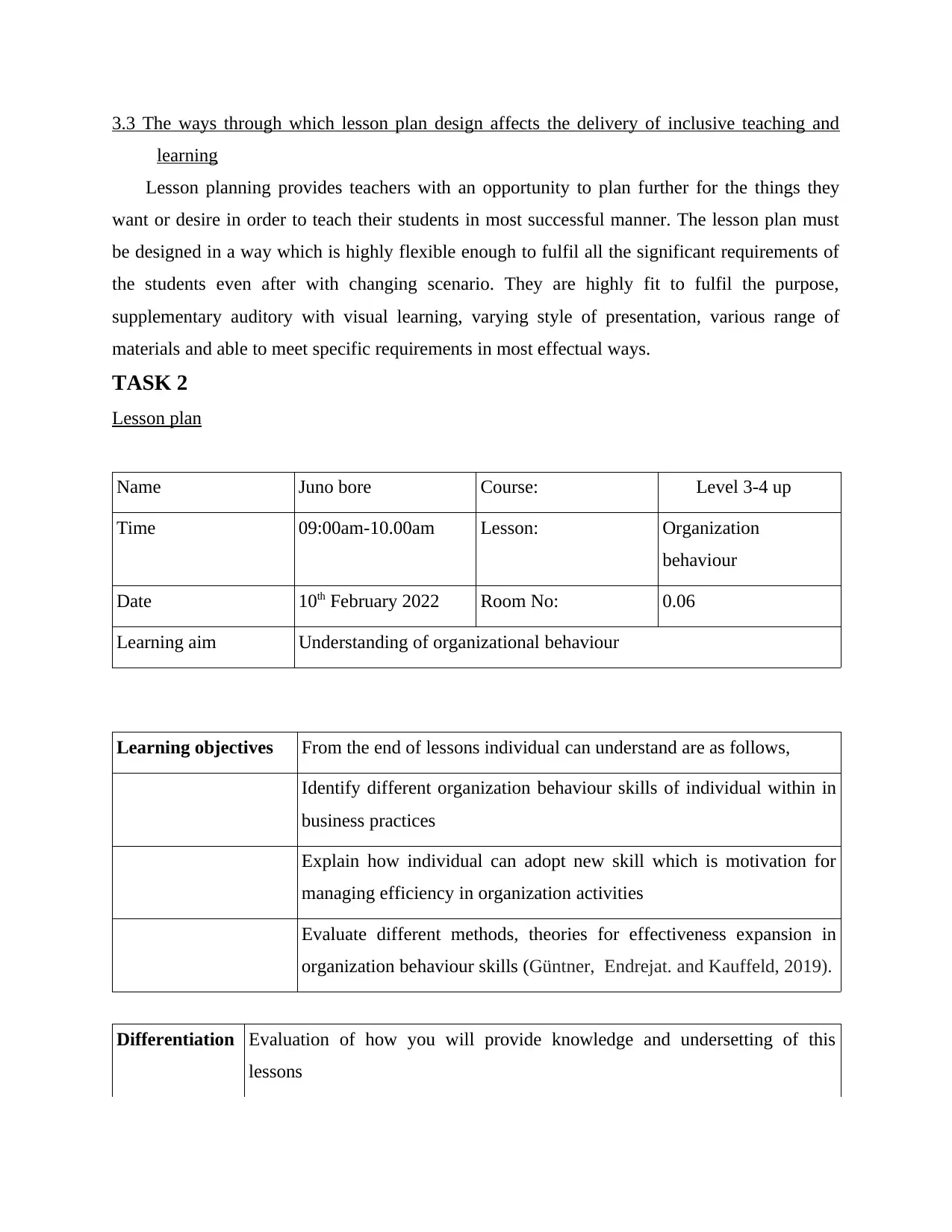
3.3 The ways through which lesson plan design affects the delivery of inclusive teaching and
learning
Lesson planning provides teachers with an opportunity to plan further for the things they
want or desire in order to teach their students in most successful manner. The lesson plan must
be designed in a way which is highly flexible enough to fulfil all the significant requirements of
the students even after with changing scenario. They are highly fit to fulfil the purpose,
supplementary auditory with visual learning, varying style of presentation, various range of
materials and able to meet specific requirements in most effectual ways.
TASK 2
Lesson plan
Name Juno bore Course: Level 3-4 up
Time 09:00am-10.00am Lesson: Organization
behaviour
Date 10th February 2022 Room No: 0.06
Learning aim Understanding of organizational behaviour
Learning objectives From the end of lessons individual can understand are as follows,
Identify different organization behaviour skills of individual within in
business practices
Explain how individual can adopt new skill which is motivation for
managing efficiency in organization activities
Evaluate different methods, theories for effectiveness expansion in
organization behaviour skills (Güntner, Endrejat. and Kauffeld, 2019).
Differentiation Evaluation of how you will provide knowledge and undersetting of this
lessons
learning
Lesson planning provides teachers with an opportunity to plan further for the things they
want or desire in order to teach their students in most successful manner. The lesson plan must
be designed in a way which is highly flexible enough to fulfil all the significant requirements of
the students even after with changing scenario. They are highly fit to fulfil the purpose,
supplementary auditory with visual learning, varying style of presentation, various range of
materials and able to meet specific requirements in most effectual ways.
TASK 2
Lesson plan
Name Juno bore Course: Level 3-4 up
Time 09:00am-10.00am Lesson: Organization
behaviour
Date 10th February 2022 Room No: 0.06
Learning aim Understanding of organizational behaviour
Learning objectives From the end of lessons individual can understand are as follows,
Identify different organization behaviour skills of individual within in
business practices
Explain how individual can adopt new skill which is motivation for
managing efficiency in organization activities
Evaluate different methods, theories for effectiveness expansion in
organization behaviour skills (Güntner, Endrejat. and Kauffeld, 2019).
Differentiation Evaluation of how you will provide knowledge and undersetting of this
lessons
Paraphrase This Document
Need a fresh take? Get an instant paraphrase of this document with our AI Paraphraser
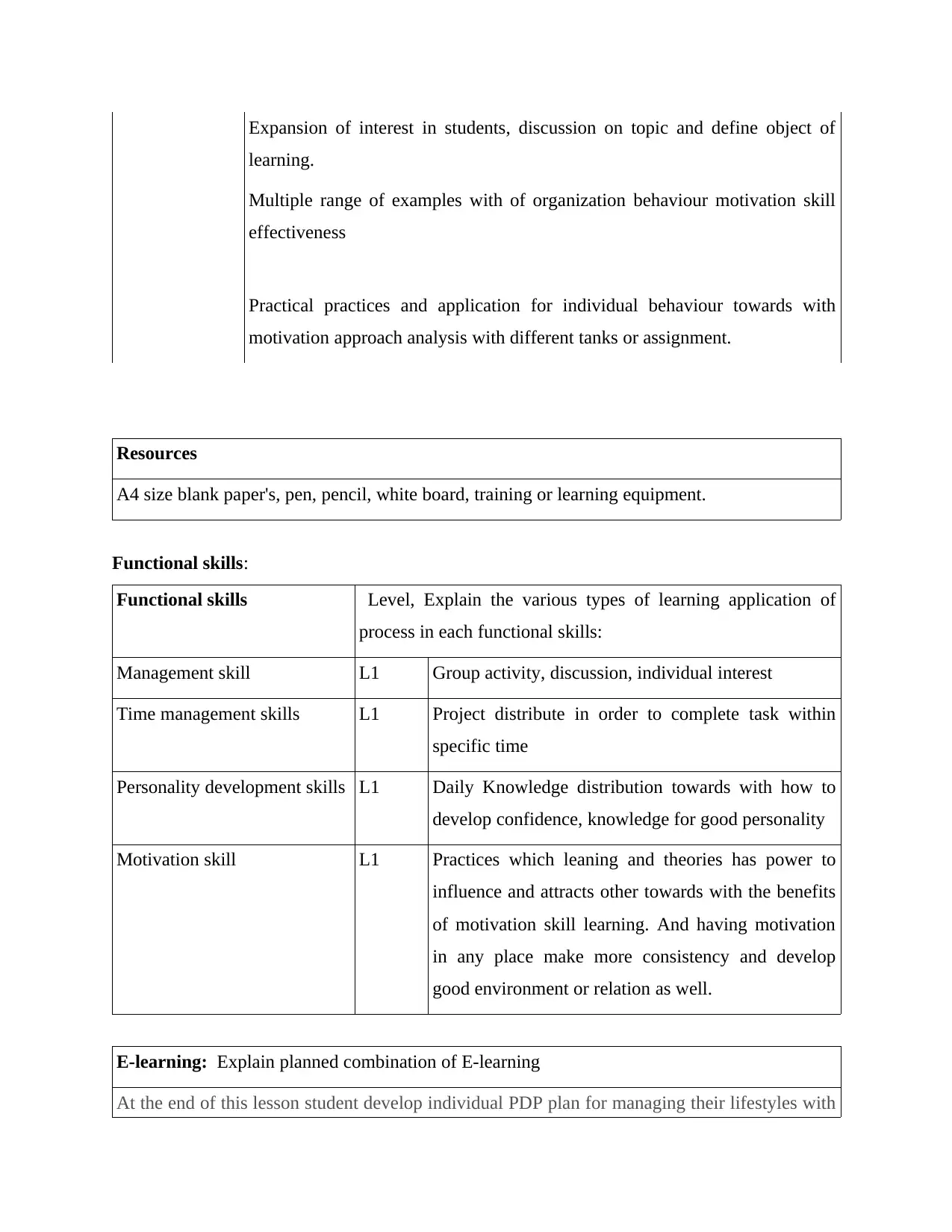
Expansion of interest in students, discussion on topic and define object of
learning.
Multiple range of examples with of organization behaviour motivation skill
effectiveness
Practical practices and application for individual behaviour towards with
motivation approach analysis with different tanks or assignment.
Resources
A4 size blank paper's, pen, pencil, white board, training or learning equipment.
Functional skills:
Functional skills Level, Explain the various types of learning application of
process in each functional skills:
Management skill L1 Group activity, discussion, individual interest
Time management skills L1 Project distribute in order to complete task within
specific time
Personality development skills L1 Daily Knowledge distribution towards with how to
develop confidence, knowledge for good personality
Motivation skill L1 Practices which leaning and theories has power to
influence and attracts other towards with the benefits
of motivation skill learning. And having motivation
in any place make more consistency and develop
good environment or relation as well.
E-learning: Explain planned combination of E-learning
At the end of this lesson student develop individual PDP plan for managing their lifestyles with
learning.
Multiple range of examples with of organization behaviour motivation skill
effectiveness
Practical practices and application for individual behaviour towards with
motivation approach analysis with different tanks or assignment.
Resources
A4 size blank paper's, pen, pencil, white board, training or learning equipment.
Functional skills:
Functional skills Level, Explain the various types of learning application of
process in each functional skills:
Management skill L1 Group activity, discussion, individual interest
Time management skills L1 Project distribute in order to complete task within
specific time
Personality development skills L1 Daily Knowledge distribution towards with how to
develop confidence, knowledge for good personality
Motivation skill L1 Practices which leaning and theories has power to
influence and attracts other towards with the benefits
of motivation skill learning. And having motivation
in any place make more consistency and develop
good environment or relation as well.
E-learning: Explain planned combination of E-learning
At the end of this lesson student develop individual PDP plan for managing their lifestyles with
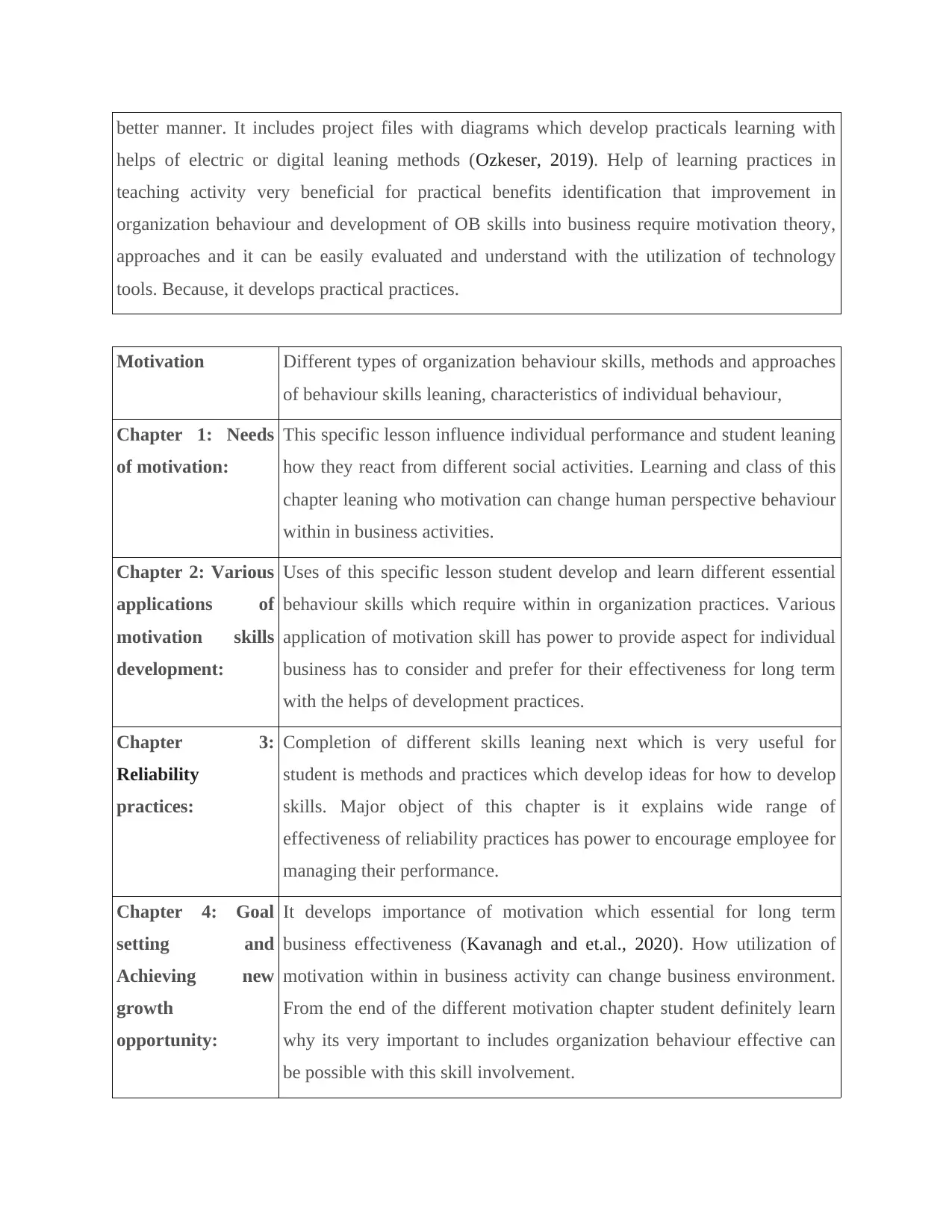
better manner. It includes project files with diagrams which develop practicals learning with
helps of electric or digital leaning methods (Ozkeser, 2019). Help of learning practices in
teaching activity very beneficial for practical benefits identification that improvement in
organization behaviour and development of OB skills into business require motivation theory,
approaches and it can be easily evaluated and understand with the utilization of technology
tools. Because, it develops practical practices.
Motivation Different types of organization behaviour skills, methods and approaches
of behaviour skills leaning, characteristics of individual behaviour,
Chapter 1: Needs
of motivation:
This specific lesson influence individual performance and student leaning
how they react from different social activities. Learning and class of this
chapter leaning who motivation can change human perspective behaviour
within in business activities.
Chapter 2: Various
applications of
motivation skills
development:
Uses of this specific lesson student develop and learn different essential
behaviour skills which require within in organization practices. Various
application of motivation skill has power to provide aspect for individual
business has to consider and prefer for their effectiveness for long term
with the helps of development practices.
Chapter 3:
Reliability
practices:
Completion of different skills leaning next which is very useful for
student is methods and practices which develop ideas for how to develop
skills. Major object of this chapter is it explains wide range of
effectiveness of reliability practices has power to encourage employee for
managing their performance.
Chapter 4: Goal
setting and
Achieving new
growth
opportunity:
It develops importance of motivation which essential for long term
business effectiveness (Kavanagh and et.al., 2020). How utilization of
motivation within in business activity can change business environment.
From the end of the different motivation chapter student definitely learn
why its very important to includes organization behaviour effective can
be possible with this skill involvement.
helps of electric or digital leaning methods (Ozkeser, 2019). Help of learning practices in
teaching activity very beneficial for practical benefits identification that improvement in
organization behaviour and development of OB skills into business require motivation theory,
approaches and it can be easily evaluated and understand with the utilization of technology
tools. Because, it develops practical practices.
Motivation Different types of organization behaviour skills, methods and approaches
of behaviour skills leaning, characteristics of individual behaviour,
Chapter 1: Needs
of motivation:
This specific lesson influence individual performance and student leaning
how they react from different social activities. Learning and class of this
chapter leaning who motivation can change human perspective behaviour
within in business activities.
Chapter 2: Various
applications of
motivation skills
development:
Uses of this specific lesson student develop and learn different essential
behaviour skills which require within in organization practices. Various
application of motivation skill has power to provide aspect for individual
business has to consider and prefer for their effectiveness for long term
with the helps of development practices.
Chapter 3:
Reliability
practices:
Completion of different skills leaning next which is very useful for
student is methods and practices which develop ideas for how to develop
skills. Major object of this chapter is it explains wide range of
effectiveness of reliability practices has power to encourage employee for
managing their performance.
Chapter 4: Goal
setting and
Achieving new
growth
opportunity:
It develops importance of motivation which essential for long term
business effectiveness (Kavanagh and et.al., 2020). How utilization of
motivation within in business activity can change business environment.
From the end of the different motivation chapter student definitely learn
why its very important to includes organization behaviour effective can
be possible with this skill involvement.
⊘ This is a preview!⊘
Do you want full access?
Subscribe today to unlock all pages.

Trusted by 1+ million students worldwide
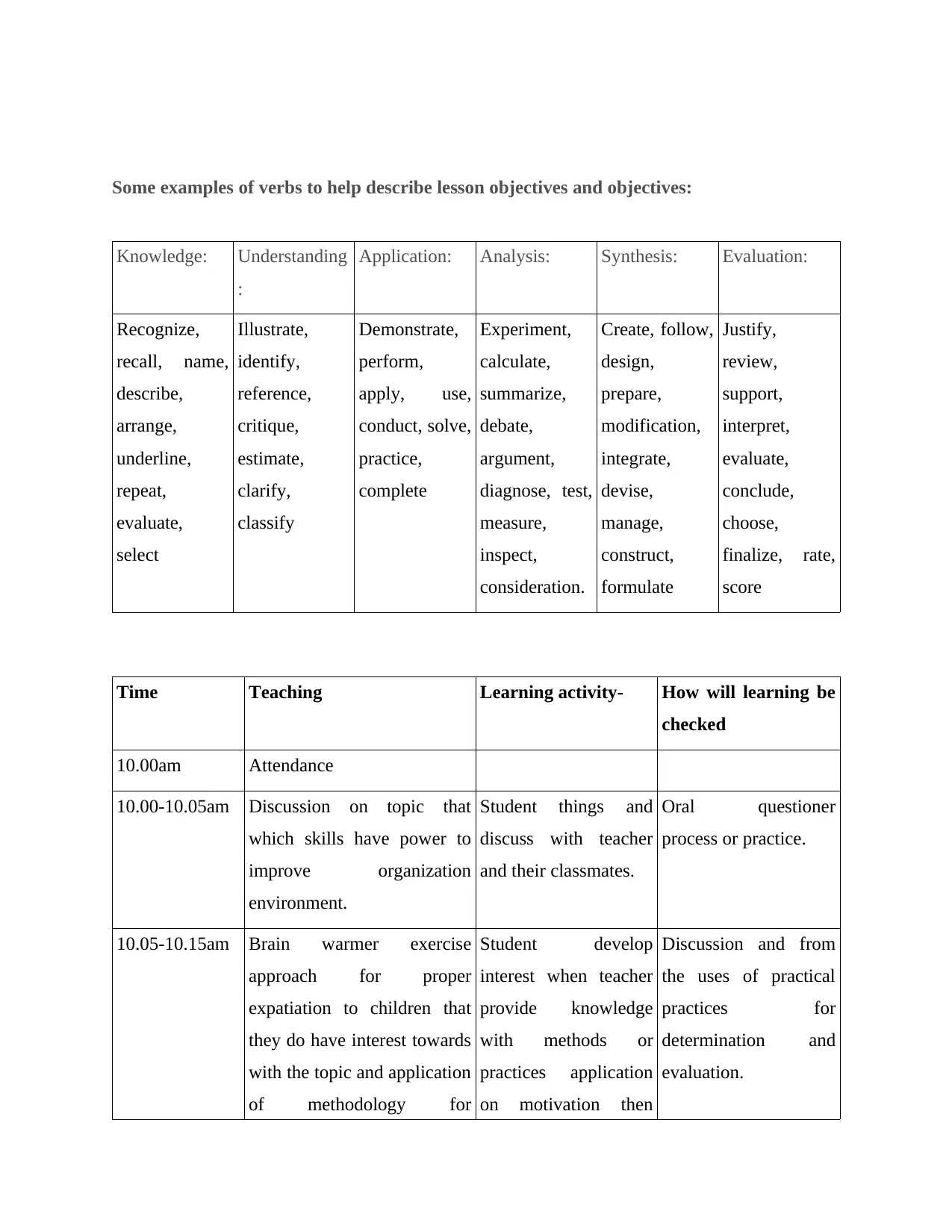
Some examples of verbs to help describe lesson objectives and objectives:
Knowledge: Understanding
:
Application: Analysis: Synthesis: Evaluation:
Recognize,
recall, name,
describe,
arrange,
underline,
repeat,
evaluate,
select
Illustrate,
identify,
reference,
critique,
estimate,
clarify,
classify
Demonstrate,
perform,
apply, use,
conduct, solve,
practice,
complete
Experiment,
calculate,
summarize,
debate,
argument,
diagnose, test,
measure,
inspect,
consideration.
Create, follow,
design,
prepare,
modification,
integrate,
devise,
manage,
construct,
formulate
Justify,
review,
support,
interpret,
evaluate,
conclude,
choose,
finalize, rate,
score
Time Teaching Learning activity- How will learning be
checked
10.00am Attendance
10.00-10.05am Discussion on topic that
which skills have power to
improve organization
environment.
Student things and
discuss with teacher
and their classmates.
Oral questioner
process or practice.
10.05-10.15am Brain warmer exercise
approach for proper
expatiation to children that
they do have interest towards
with the topic and application
of methodology for
Student develop
interest when teacher
provide knowledge
with methods or
practices application
on motivation then
Discussion and from
the uses of practical
practices for
determination and
evaluation.
Knowledge: Understanding
:
Application: Analysis: Synthesis: Evaluation:
Recognize,
recall, name,
describe,
arrange,
underline,
repeat,
evaluate,
select
Illustrate,
identify,
reference,
critique,
estimate,
clarify,
classify
Demonstrate,
perform,
apply, use,
conduct, solve,
practice,
complete
Experiment,
calculate,
summarize,
debate,
argument,
diagnose, test,
measure,
inspect,
consideration.
Create, follow,
design,
prepare,
modification,
integrate,
devise,
manage,
construct,
formulate
Justify,
review,
support,
interpret,
evaluate,
conclude,
choose,
finalize, rate,
score
Time Teaching Learning activity- How will learning be
checked
10.00am Attendance
10.00-10.05am Discussion on topic that
which skills have power to
improve organization
environment.
Student things and
discuss with teacher
and their classmates.
Oral questioner
process or practice.
10.05-10.15am Brain warmer exercise
approach for proper
expatiation to children that
they do have interest towards
with the topic and application
of methodology for
Student develop
interest when teacher
provide knowledge
with methods or
practices application
on motivation then
Discussion and from
the uses of practical
practices for
determination and
evaluation.
Paraphrase This Document
Need a fresh take? Get an instant paraphrase of this document with our AI Paraphraser
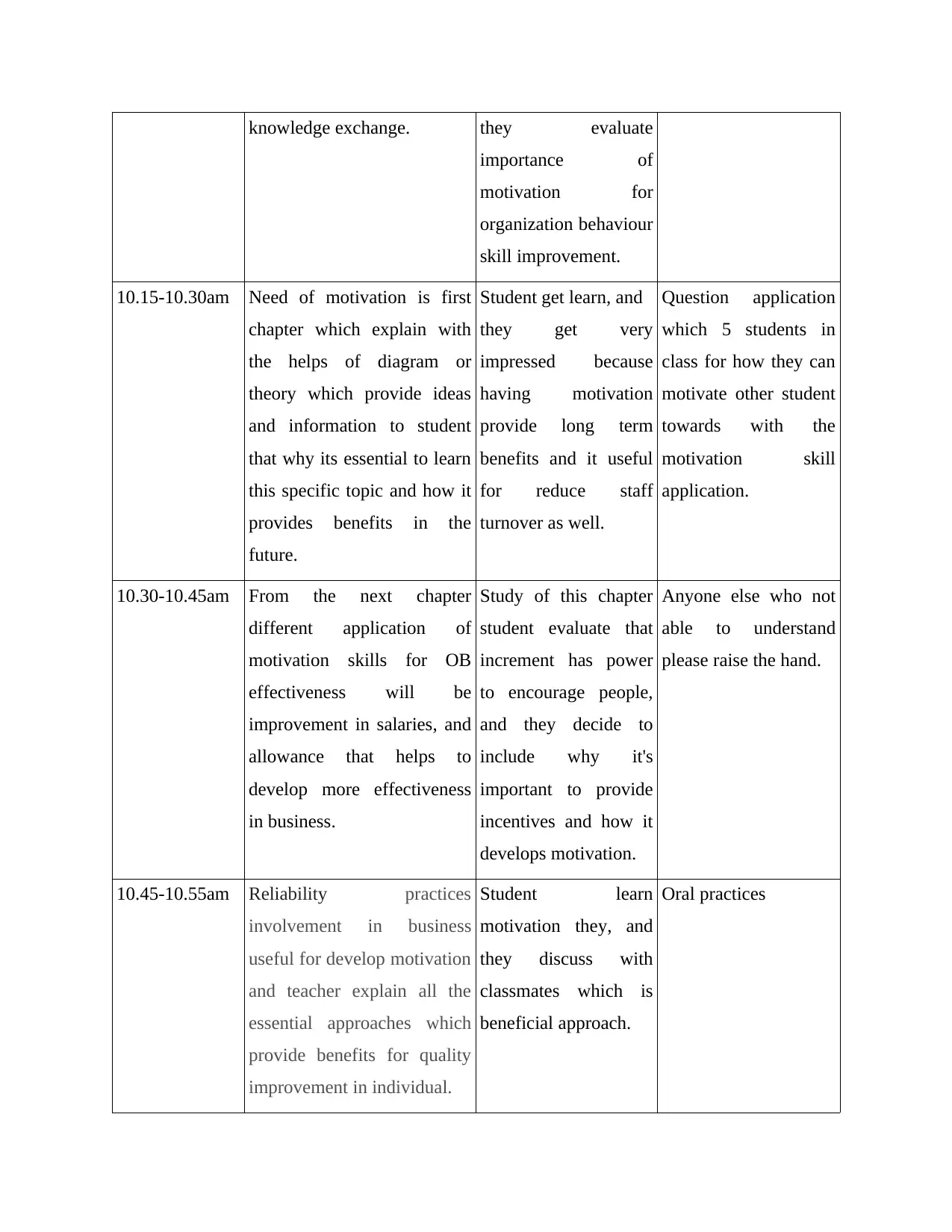
knowledge exchange. they evaluate
importance of
motivation for
organization behaviour
skill improvement.
10.15-10.30am Need of motivation is first
chapter which explain with
the helps of diagram or
theory which provide ideas
and information to student
that why its essential to learn
this specific topic and how it
provides benefits in the
future.
Student get learn, and
they get very
impressed because
having motivation
provide long term
benefits and it useful
for reduce staff
turnover as well.
Question application
which 5 students in
class for how they can
motivate other student
towards with the
motivation skill
application.
10.30-10.45am From the next chapter
different application of
motivation skills for OB
effectiveness will be
improvement in salaries, and
allowance that helps to
develop more effectiveness
in business.
Study of this chapter
student evaluate that
increment has power
to encourage people,
and they decide to
include why it's
important to provide
incentives and how it
develops motivation.
Anyone else who not
able to understand
please raise the hand.
10.45-10.55am Reliability practices
involvement in business
useful for develop motivation
and teacher explain all the
essential approaches which
provide benefits for quality
improvement in individual.
Student learn
motivation they, and
they discuss with
classmates which is
beneficial approach.
Oral practices
importance of
motivation for
organization behaviour
skill improvement.
10.15-10.30am Need of motivation is first
chapter which explain with
the helps of diagram or
theory which provide ideas
and information to student
that why its essential to learn
this specific topic and how it
provides benefits in the
future.
Student get learn, and
they get very
impressed because
having motivation
provide long term
benefits and it useful
for reduce staff
turnover as well.
Question application
which 5 students in
class for how they can
motivate other student
towards with the
motivation skill
application.
10.30-10.45am From the next chapter
different application of
motivation skills for OB
effectiveness will be
improvement in salaries, and
allowance that helps to
develop more effectiveness
in business.
Study of this chapter
student evaluate that
increment has power
to encourage people,
and they decide to
include why it's
important to provide
incentives and how it
develops motivation.
Anyone else who not
able to understand
please raise the hand.
10.45-10.55am Reliability practices
involvement in business
useful for develop motivation
and teacher explain all the
essential approaches which
provide benefits for quality
improvement in individual.
Student learn
motivation they, and
they discuss with
classmates which is
beneficial approach.
Oral practices
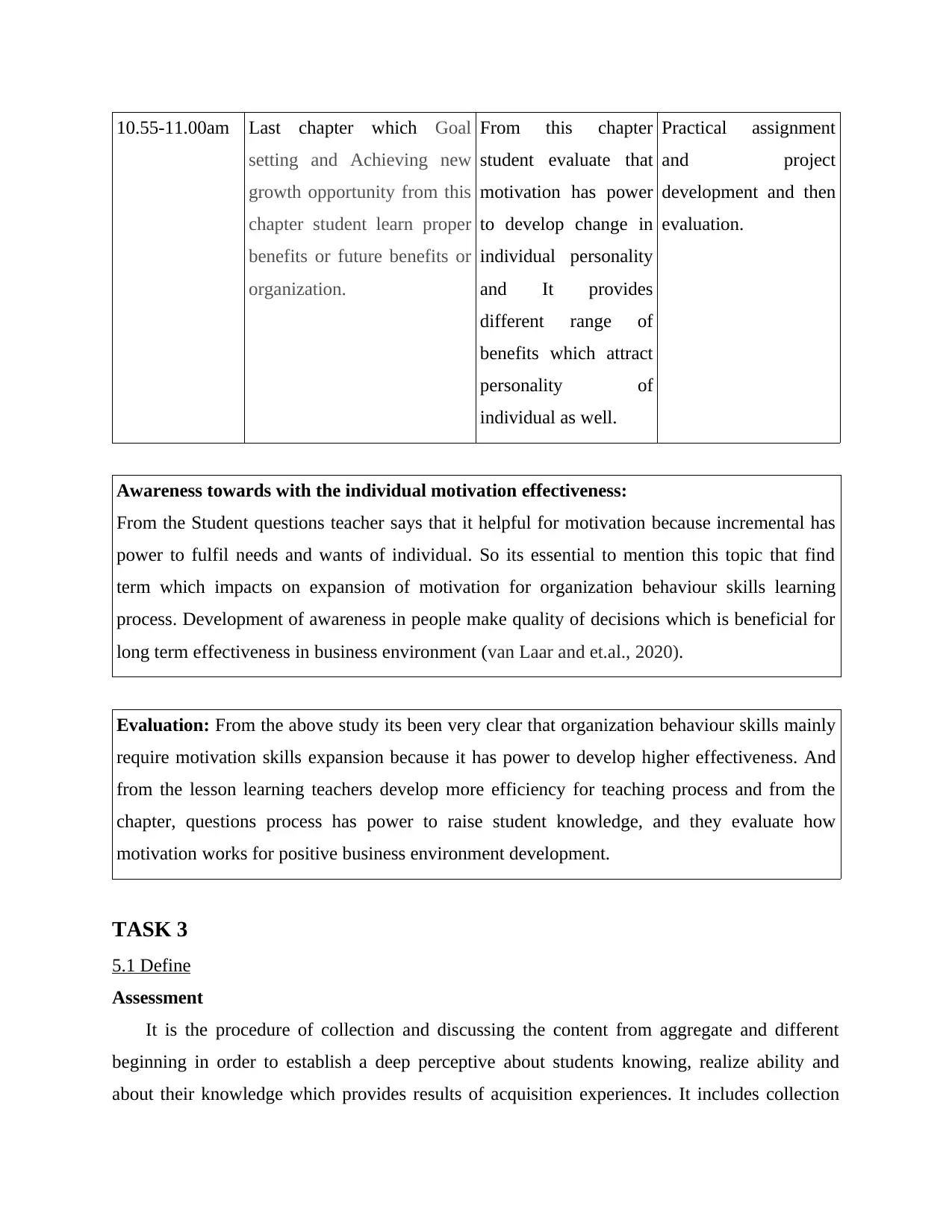
10.55-11.00am Last chapter which Goal
setting and Achieving new
growth opportunity from this
chapter student learn proper
benefits or future benefits or
organization.
From this chapter
student evaluate that
motivation has power
to develop change in
individual personality
and It provides
different range of
benefits which attract
personality of
individual as well.
Practical assignment
and project
development and then
evaluation.
Awareness towards with the individual motivation effectiveness:
From the Student questions teacher says that it helpful for motivation because incremental has
power to fulfil needs and wants of individual. So its essential to mention this topic that find
term which impacts on expansion of motivation for organization behaviour skills learning
process. Development of awareness in people make quality of decisions which is beneficial for
long term effectiveness in business environment (van Laar and et.al., 2020).
Evaluation: From the above study its been very clear that organization behaviour skills mainly
require motivation skills expansion because it has power to develop higher effectiveness. And
from the lesson learning teachers develop more efficiency for teaching process and from the
chapter, questions process has power to raise student knowledge, and they evaluate how
motivation works for positive business environment development.
TASK 3
5.1 Define
Assessment
It is the procedure of collection and discussing the content from aggregate and different
beginning in order to establish a deep perceptive about students knowing, realize ability and
about their knowledge which provides results of acquisition experiences. It includes collection
setting and Achieving new
growth opportunity from this
chapter student learn proper
benefits or future benefits or
organization.
From this chapter
student evaluate that
motivation has power
to develop change in
individual personality
and It provides
different range of
benefits which attract
personality of
individual as well.
Practical assignment
and project
development and then
evaluation.
Awareness towards with the individual motivation effectiveness:
From the Student questions teacher says that it helpful for motivation because incremental has
power to fulfil needs and wants of individual. So its essential to mention this topic that find
term which impacts on expansion of motivation for organization behaviour skills learning
process. Development of awareness in people make quality of decisions which is beneficial for
long term effectiveness in business environment (van Laar and et.al., 2020).
Evaluation: From the above study its been very clear that organization behaviour skills mainly
require motivation skills expansion because it has power to develop higher effectiveness. And
from the lesson learning teachers develop more efficiency for teaching process and from the
chapter, questions process has power to raise student knowledge, and they evaluate how
motivation works for positive business environment development.
TASK 3
5.1 Define
Assessment
It is the procedure of collection and discussing the content from aggregate and different
beginning in order to establish a deep perceptive about students knowing, realize ability and
about their knowledge which provides results of acquisition experiences. It includes collection
⊘ This is a preview!⊘
Do you want full access?
Subscribe today to unlock all pages.

Trusted by 1+ million students worldwide
1 out of 19
Related Documents
Your All-in-One AI-Powered Toolkit for Academic Success.
+13062052269
info@desklib.com
Available 24*7 on WhatsApp / Email
![[object Object]](/_next/static/media/star-bottom.7253800d.svg)
Unlock your academic potential
Copyright © 2020–2025 A2Z Services. All Rights Reserved. Developed and managed by ZUCOL.



